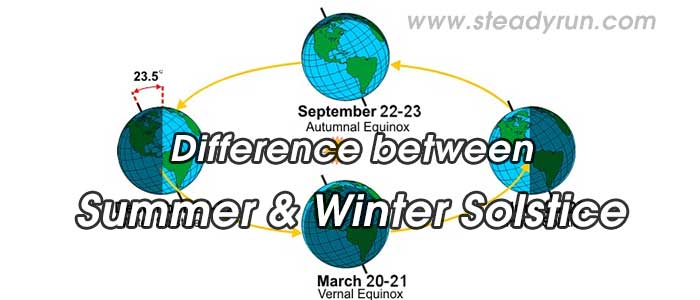How to Use Design Principles to Boost Your YouTube Channel's Appeal

Distinguish, differentiate, compare and explain what is the Difference between Summer and Winter Solstice. Comparison and Differences.
Understanding Movements of the Sun in the Sky
Most people are aware that the Sun rises in the east and sets in the west. Although ancient cultures were acutely aware of the movements of the Sun, Moon, planets, and stars, few modern people understand that the sunrise and sunset locations on the horizon change slightly each day. Nor are many people aware that, except near the equator, the Sun rises on a diagonal.
On the summer solstice, the Sun rises as far northeast as it ever gets, and sets as far northwest as it gets. This results in many hours of daylight, and summer. On the model, the summer solstice is represented by the longest cord.
Comparison between Summer and Winter Solstice
Every day from summer solstice the Sun rises and sets a bit further south. Three months later it rises due east and sets due west, which we call the equinox. Now, we have roughly equal hours of daylight and nighttime, and it is the start of fall. Your model shows this as the medium-length cord that runs from due east to due west.
The Sun continues its southward march until, on the winter solstice, it rises as far southeast as it gets and sets as far southwest. The Sun’s track is low in the sky and we have fewer hours of daylight than nighttime. It is winter, dark and cold. Your model shows this as the shortest cord.
After the winter solstice, the Sun starts working its way back up to the northeast and the pattern repeats. Note that, because of the tilt of the Earth, the Sun is never directly overhead, except if one is at a latitude of fewer than 23.5 degrees.

The 2 main points of differ:
1. During the summer solstice, the Earths axis is tilted toward the sun the furthest. It is the longest daylight for the Northern Hemisphere. During the winter solstice, the Earths axis is tilted away from the sun the furthest. It is the shortest daylight for the Northern Hemisphere.
2. In the Northern Hemisphere the longest day and the shortest night occur on 21st June. At this time in the Southern Hemisphere, it occurs the shortest day and the longest night. This position of the earth is called summer solstice. Winter Solstice: In the Northern Hemisphere the shortest day and the longest night occur on 22nd December. At this time in the Southern Hemisphere, it occurs the longest day and the shortest night. This position of the earth is known as Winter solstice.
Tags:
Difference between Winter Solstice vs Summer
Summer vs Winter Solstice
Differences between Winter Solstice vs Summer
Image Credits: Freepik








